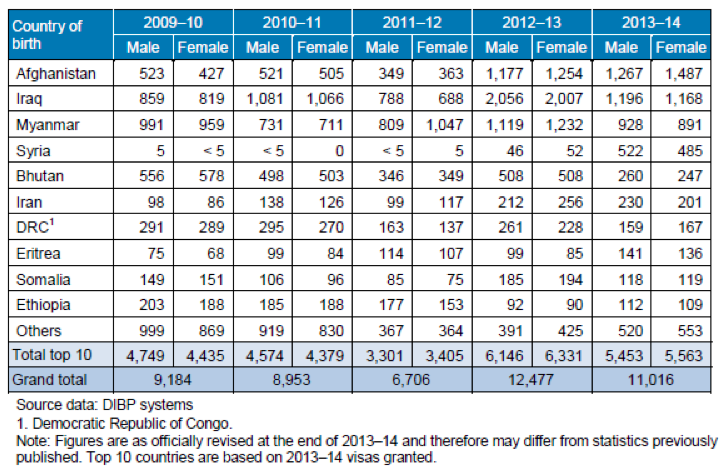Humans migrate to more secure places for their survival. Migration is one of the most common evolutionary behaviour in the natural world humans belong to. Some people have to look for a safer place to escape from imminent danger. Others do so because they deem there are better chances of short-term and long-term survival in the country of destination, compared to their own.
The main cause of contemporary migration is still economic, but the motivations to move to another country are becoming increasingly more complex, from pure economic opportunities to personal and political security, and to health and environmental factors. For those who want to migrate to another country, people reply on their friends and families, community leaders, migrant agents and law enforcers who all influence migrants’ decisions to move to which country and through which route. They learn form past experiences and adapt to new cultures and environments.
Who are migrating to Australia?
Historically, it was British and Europeans who came to settle their new lives in Australia. However, in the past two decades, Australia receives more Asian migrants who are educated and skilled.
[Top 10 Countries of Birth of the Overseas-born Population since 1901]

[Source: Migration to Australia since federation. Parliament of Australia, 2010]
Among the top 5 source countries of net migration to Australia in 2011-2, 3 are from Asia. What is more interesting is, if you look at the top 10 source countries for point-based skilled permanent migration, seven are from Asia. India and China alone make up 44% of the total point-based permanent skilled migrants. Temporary skilled migration (subclass 457) also indicates that more Asians coming to Australia, than Europeans. Australia should look to Asia if it wants to attract the best and the brightest.
https://public.tableau.com/javascripts/api/viz_v1.js
Asia tops not just the skilled migration stream but also the humanitarian one. Of the top 10 source countries for humanitarian visas, the half is from West and Southeast Asia: Afghanistan, Iraq, Myanmar, Bhutan and Iran.
[Top 10 Source Countries for Humanitarian Visas, 2009-14]

However, one should not exaggerate the scale of the refugee intake in Australia. In 2014, out of 207,947 permanent migrants, most were through the skill stream (61.8%). The country’s humanitarian program takes up the fixed annual intake around 13,750 (around 6.6%). Despite the relatively small portion compared to the entire migration programme, Rohingya asylum seekers and Bangladeshi economic migrants received disproportional attention from the mainstream media in Australia as if Asian migrants are generally poor, helpless and deprived, which isn’t true. Most Asian migrants bring skills and knowledge to Australia’s economy and society.
Unlike Europe that faces millions of migrants spilling over from the neighbouring regions of the Middle East and Africa, Australia does not experience the same scale of mass migration. Given the increasing number of illegal boat arrivals in 2008-2013, the government decided to operate military means to stop the boats while maintaining the fixed annual intake. The Operation Sovereign Borders, introduced in September 2013, certainly deterred illegal boat arrivals and the number plunged down significantly. However, among many turned back by Australia are refugees under international law who face persecution and systematic discrimination back in their countries of origin.
Besides the lack of access to justice, inadequate living conditions and unsafe environments for women and children, the government spending on the offshore processing in Manus and Nauru islands as well as Cambodia is proven not cost-effective. The government currently spends more than $1 billion for running its offshore programmes while the UNHCR budget for entire Southeast Asia is around $204 million in 2015. Money can be spent more wisely elsewhere to save more lives who’re in needs of humanitarian assistance.
How the Abbott government dealt with Asian asylum seekers and bought its poor neighbours to poorly manage highly vulnerable asylum seekers has left a damning image of Australia for its Asia-Pacific neighbours. Australia is a mature democracy many educated Asians are attracted to. It can do a lot more and better to lead the region.
